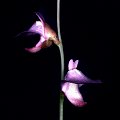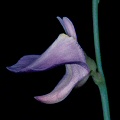| Utricularia section Australes | ||
|---|---|---|
| Species | Range | Habit1 |
| U. delicatula | NZ | T |
| U. lateriflora | se Australia | T |
| U. simplex | sw Australia | T |
| 1T=terrestrial. | ||
Q: About Utricularia subgenus Bivalvaria section Australes
A: This Utricularia section has a number of similarities to sections
Pleiochasia and Meionula, although a suite of trap, rhizoid, and
floral characters separate them. Peter Taylor has spent some space in his monograph discusssing the similarities of the three
sections, which is interesting, since these three sections have since been flung apart to the
three subgenera in the genus.
These plants present little challenge to the horticulturist, although I must admit I have not grown
U. simplex. (I do not think it should be different from the others, though.) Treat them as moist, tropical,
terrestrials, and you should do fine. For more details on the cultivation of these plants, you can see
a paper I wrote on them way back in 1994.
Utricularia delicatula
This plant is similar to Utricularia lateriflora,
and the most reliable whay to tell them apart is that there are almost never any scales located between the flowers on the flower
stalk.
Utricularia lateriflora
The most commonly-grown species in this section. The flowers of this
species are scattered along the inflorescence, and the clones that I have grown seem to have their flowers in almost-pairs along
the scape axis. A key character of this species is that there are scales distributed along the flower stalk, between the
developed flowers.
Utricularia simplex
A single-flowered plant. It can also be separated from the others by the fact that
its upper corolla lobe flares to a width greater than the width of the upper caylx lobe. I have neither grown nor seen this
species yet.
Page citations: Rice, B.A. 1994d, 2006a; Taylor, P. 1989; personal observations.

